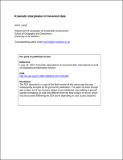Files in this item
Kinematic interpolation of movement data
Item metadata
| dc.contributor.author | Long, Jed | |
| dc.date.accessioned | 2016-09-17T23:34:10Z | |
| dc.date.available | 2016-09-17T23:34:10Z | |
| dc.date.issued | 2016 | |
| dc.identifier | 218825103 | |
| dc.identifier | 42282f30-c7fc-4564-97b8-ac73f885162a | |
| dc.identifier | 84961208229 | |
| dc.identifier | 000372355600003 | |
| dc.identifier.citation | Long , J 2016 , ' Kinematic interpolation of movement data ' , International Journal of Geographical Information Science , vol. 30 , no. 5 , pp. 854-868 . https://doi.org/10.1080/13658816.2015.1081909 | en |
| dc.identifier.issn | 1365-8816 | |
| dc.identifier.uri | https://hdl.handle.net/10023/9520 | |
| dc.description.abstract | Mobile tracking technologies are facilitating the collection of increasingly large and detailed data sets on object movement. Movement data are collected by recording an object’s location at discrete time intervals. Often, of interest is to estimate the unknown position of the object at unrecorded time points to increase the temporal resolution of the data, to correct erroneous or missing data points, or to match the recorded times between multiple data sets. Estimating an object’s unknown location between known locations is termed path interpolation. This paper introduces a new method for path interpolation termed kinematic interpolation. Kinematic interpolation incorporates object kinematics (i.e. velocity and acceleration) into the interpolation process. Six empirical data sets (two types of correlated random walks, caribou, cyclist, hurricane and athlete tracking data) are used to compare kinematic interpolation to other interpolation algorithms. Results showed kinematic interpolation to be a suitable interpolation method with fast-moving objects (e.g. the cyclist, hurricane and athlete tracking data), while other algorithms performed best with the correlated random walk and caribou data. Several issues associated with path interpolation tasks are discussed along with potential applications where kinematic interpolation can be useful. Finally, code for performing path interpolation is provided (for each method compared within) using the statistical software R. | |
| dc.format.extent | 15 | |
| dc.format.extent | 420476 | |
| dc.language.iso | eng | |
| dc.relation.ispartof | International Journal of Geographical Information Science | en |
| dc.subject | Spatio-temporal data modelling | en |
| dc.subject | Mobility | en |
| dc.subject | Mobile objects | en |
| dc.subject | Personal movement models | en |
| dc.subject | Spatio-temporal query | en |
| dc.subject | GA Mathematical geography. Cartography | en |
| dc.subject | Information Systems | en |
| dc.subject | Transportation | en |
| dc.subject | NDAS | en |
| dc.subject | BDC | en |
| dc.subject.lcc | GA | en |
| dc.title | Kinematic interpolation of movement data | en |
| dc.type | Journal article | en |
| dc.contributor.institution | University of St Andrews. Geography & Sustainable Development | en |
| dc.contributor.institution | University of St Andrews. Bell-Edwards Geographic Data Institute | en |
| dc.identifier.doi | https://doi.org/10.1080/13658816.2015.1081909 | |
| dc.description.status | Peer reviewed | en |
| dc.date.embargoedUntil | 2016-09-17 | |
| dc.identifier.url | http://www.tandfonline.com/doi/suppl/10.1080/13658816.2015.1081909#tabModule | en |
This item appears in the following Collection(s)
Items in the St Andrews Research Repository are protected by copyright, with all rights reserved, unless otherwise indicated.

